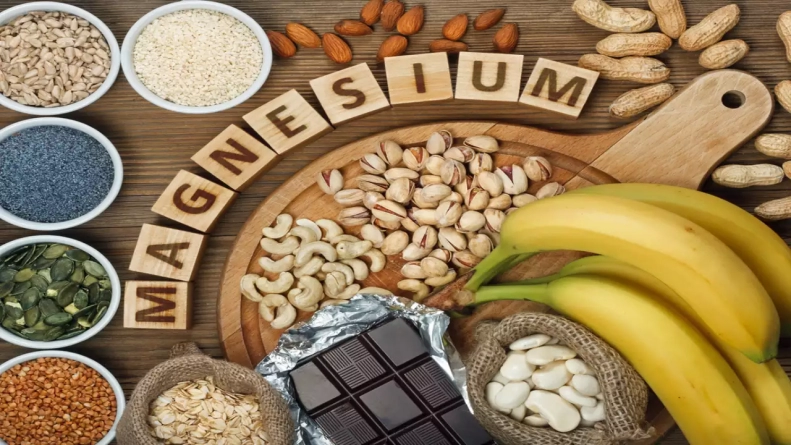-
LONDON: Indian-Origin Teen In UK Gets “Life-Changing” Cancer Treatment - 1 day ago
-
SILICON VALLEY: All About Pavan Davuluri, New Head Of Microsoft Windows - 1 day ago
-
LONDON: UK’s India Gate To Commemorate Role Of Indian Soldiers From World Wars - April 24, 2024
-
HARARE: Shri Bramha Kumar appointed as the next Ambassador of India to the Republic of Zimbabwe - April 23, 2024
-
LONDON: Indian-Origin Principal Wins UK Legal Challenge Over School Prayer Ban - April 23, 2024
-
TORONTO: Indian-Origin Doctor Needs ₹ 2 Crore For Legal Fees. Elon Musk Responds - April 22, 2024
-
KINSHASA: India-Democratic Republic of Congo Foreign Office Consultations - April 21, 2024
-
LONDON: UK Court Allows Sale Of Nirav Modi’s Luxury London Apartment - April 21, 2024
-
TEHRAN: Travel advisory for Iran and Israel - April 20, 2024
-
LUXEMBOURG: Shri Saurabh Kumar concurrently accredited as the next Ambassador of India to the Grand Duchy of Luxembourg - April 20, 2024
TORONTO : 10 Magnesium-Rich Foods That Are Super Healthy
TORONTO : We include products we think are useful for our readers. If you buy through links on this page, we may earn a small commission.
Magnesium is found in a variety of nutrient-dense foods, including whole grains, nuts, seeds, legumes, and several fruits and vegetables.
Magnesium is an extremely important mineral.
It’s involved in hundreds of chemical reactions in your body and helps you maintain good health, but many people don’t reach the Daily Value (DV) of 420 milligrams (mg).
Yet, you can easily meet your daily needs by eating foods high in magnesium.
Here are 10 healthy foods that are high in magnesium.
1. Dark chocolate
Dark chocolate is as nutritious as it is flavorful.
It’s very rich in magnesium, with 65 mg in a 1-ounce (oz.), or 28-gram (g), serving, which is about 15% of the DV.
Dark chocolate is also in high in iron, copper, and manganese and contains prebiotic fiber that can help feed the beneficial bacteria in the gut.
What’s more, it’s loaded with beneficial antioxidants. These are nutrients that neutralize free radicals, which are harmful molecules that can damage your cells and lead to disease.
Dark chocolate is especially beneficial for heart health, as it contains flavanols, which are powerful antioxidant compounds that prevent LDL (bad) cholesterol from oxidizing and sticking to the cells that line your arteries.
To make the most of dark chocolate’s benefits, choose a product containing at least 70% cocoa solids. A higher percentage is even better.
summary
A 1-oz. (28-g) serving of dark chocolate provides 15% of the DV for magnesium. It’s also beneficial for gut and heart health and is loaded with antioxidants.
2. Avocados
The avocado is an incredibly nutritious fruit and a tasty source of magnesium. One medium avocado provides 58 mg of magnesium, which is 14% of the DV.
Avocados are also high in potassium, B vitamins, and vitamin K. Plus, unlike most fruits, they’re high in fat — especially heart-healthy monounsaturated fat.
In addition, avocados are an excellent source of fiber. In fact, most of the carbs in an avocado come from fiber, making it very low in digestible carbs.
Studies have shown that eating avocados can reduce inflammation, improve cholesterol levels, and increase feelings of fullness after meals.
summary
A medium avocado provides 14% of the DV for magnesium. Avocados are packed with several other nutrients and may help reduce inflammation, improve cholesterol levels, and increase fullness.
3. Nuts
Nuts are nutritious and tasty.
Types of nuts that are particularly high in magnesium include almonds, cashews, and Brazil nuts.
For instance, a 1-oz. (28-g) serving of cashews contains 83 mg of magnesium, or 20% of the DV.
Most nuts are also a good source of fiber and monounsaturated fat and have been shown to improve blood sugar and cholesterol levels in people with diabetes.
Brazil nuts are also extremely high in selenium. In fact, just one Brazil nut provides nearly 175% of the DV for this mineral.
Additionally, nuts are anti-inflammatory, beneficial for heart health, and can reduce appetite when eaten as snacks.
summary
Cashews, almonds, and Brazil nuts are high in magnesium and many other essential nutrients. A single serving of cashews provides 20% of the DV.
4. Legumes
Legumes are a family of nutrient-dense plants that include lentils, beans, chickpeas, peas, and soybeans.
They’re very rich in many different nutrients, including magnesium.
For instance, a 1-cup (172-g) serving of cooked black beans contains an impressive 120 mg of magnesium, which is 29% of the DV.
Legumes are also high in potassium and iron and a major source of protein for vegetarians.
Because legumes are rich in fiber and have a low glycemic index (GI), they may help lower cholesterol levels, improve blood sugar control, and reduce the risk of heart disease.
A fermented soybean product known as natto is also considered an excellent source of vitamin K2, which is important for bone health.
summary
Legumes are magnesium-rich foods. For example, a 1-cup (172-g) serving of black beans contains 29% of the DV of magnesium.
5. Tofu
Tofu is a staple food in vegetarian diets due to its high protein content. Made by pressing soybean milk into soft white curds, it’s also known as bean curd.
A 3.5-oz. (100-g) serving contains 35 mg of magnesium, which is 8% of the DV.
One serving also provides 10 g of protein and a good amount of calcium, iron, manganese, and selenium.
Additionally, some studies suggest that eating tofu and other soy products can protect the cells lining your arteries and may be associated with a decreased risk of stomach cancer.
summary
A serving of tofu provides 8% of the DV for magnesium. It’s also a good source of protein and several other nutrients.
6. Seeds
Seeds are incredibly healthy.
Many varieties — including flax, pumpkin, and chia seeds — also contain high amounts of magnesium.
Pumpkin seeds are a particularly good source, with 168 mg in a 1-oz. (28-g) serving. This amounts to a whopping 40% of the DV for magnesium.
In addition, seeds are rich in iron, monounsaturated fat, and omega-3 fatty acids.
What’s more, they’re extremely high in fiber. In fact, nearly half of the carbs in most seeds come from fiber.
They also contain antioxidants, which protect your cells from harmful free radicals produced during metabolism.
Flaxseed has also been shown to reduce cholesterol levels and may have benefits against breast cancer.
summary
Most seeds are rich in magnesium. In fact, a 1-oz. (28-g) serving of pumpkin seeds contains around 40% of the DV.
7. Whole grains
Grains include wheat, oats, and barley, as well as pseudocereals like buckwheat and quinoa.
Whole grains are excellent sources of many nutrients, including magnesium.
A 1-cup (168-g) serving of cooked buckwheat contains 86 mg of magnesium, which is 20% of the DV.
Many whole grains are also high in B vitamins, selenium, manganese, and fiber.
In controlled studies, whole grains have even been shown to reduce inflammation and decrease several risk factors for heart disease.
summary
Whole grains are high in many nutrients, including magnesium. A 1-cup (168-g) serving of cooked buckwheat provides 20% of the DV for magnesium.
8. Some fatty fish
Fish, especially fatty fish, is incredibly nutritious.
Many types of fish are high in magnesium, including salmon, mackerel, and halibut.
In fact, a 3.5-oz. (100-g) serving of cooked salmon packs 30 mg of magnesium, which is 7% of the DV.
It also provides an impressive 22 g of high quality protein.
In addition, fish is rich in potassium, selenium, B vitamins, and various other nutrients.
What’s more, a high intake of fatty fish has been linked to a decreased risk of several chronic conditions, including heart disease.
These benefits have been attributed to the high amounts of omega-3 fatty acids.
summary
Fatty fish is exceptionally nutritious and a great source of magnesium and other nutrients. A 3.5-oz. (100-g) serving of cooked salmon delivers 7% of the DV for magnesium.
9. Bananas
Bananas are among the most popular fruits in the world.
They’re most well-known for their high potassium content, which can lower blood pressure and is linked to a reduced risk of heart disease.
Plus, they’re also rich in magnesium, with 37 mg of magnesium, or 9% of the DV, in one large banana.
In addition, bananas provide vitamin C, vitamin B6, manganese, and fiber.
Ripe bananas are higher in sugar and carbs than most other fruits, so they may not be suitable for people following a low carb diet.
However, a large portion of the carbs in unripe bananas is resistant starch, which doesn’t get digested and absorbed.
Resistant starch may also help lower blood sugar levels, reduce inflammation, and improve gut health.
summary
Bananas are a good source of several nutrients. One large banana contains 9% of the DV for magnesium.
10. Leafy greens
Leafy greens are highly nutritious and many types are loaded with magnesium.
Leafy greens with significant amounts of magnesium include kale, spinach, collard greens, turnip greens, and mustard greens.
For instance, a 1-cup (180-g) serving of cooked spinach has 158 mg of magnesium, or 37% of the DV.
In addition, leafy greens like spinach are also an excellent source of several nutrients, including iron, manganese, and vitamins A, C, and K.
Leafy greens also contain many beneficial plant compounds, which help protect your cells from damage and may reduce cancer risk.
summary
Leafy greens are a very good source of many nutrients, including magnesium. A 1-cup (180-g) serving of cooked spinach provides an impressive 37% of the DV.
The bottom line
Magnesium is an important mineral that you may not be getting enough of in your daily diet.
Fortunately, there are many nutritious foods that can help you meet your needs.
Be sure to eat a balanced diet that includes some of the foods listed above to boost your intake of magnesium and many other important nutrients.























